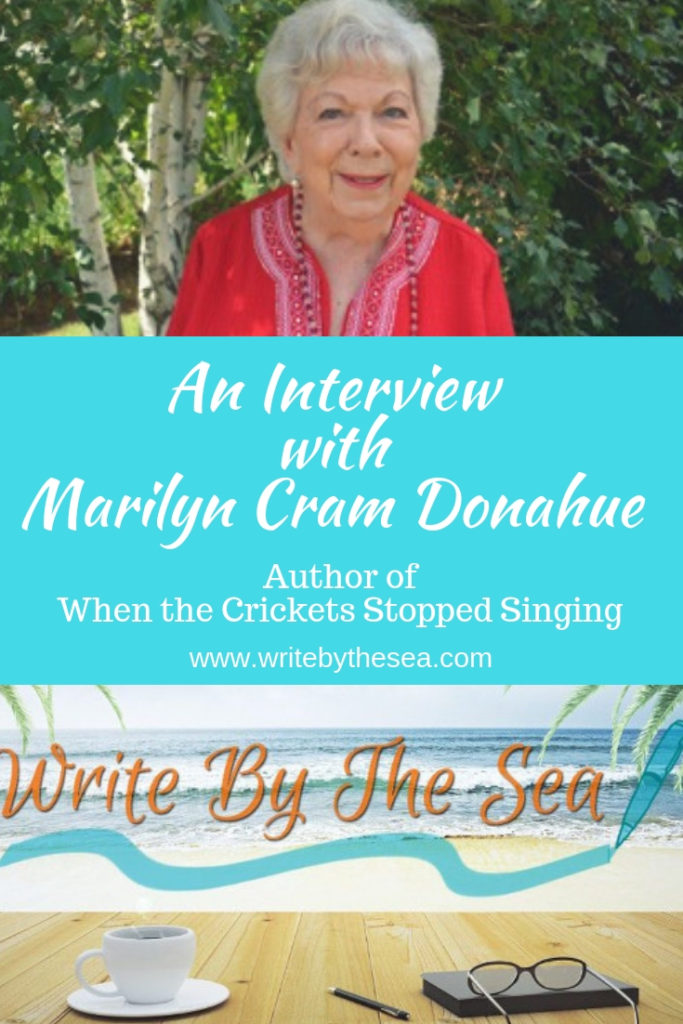If you’re a writer, it’s always fun (and helpful for your own writing) to learn more about successful authors, particularly, how they got started writing.
In part 1 of this 3-part interview with author Marilyn Cram Donahue, you’ll find out how Marilyn got her start as a writer and the kinds of things she writes.

Question:
Can you tell readers a bit about your background and the kinds of things you write?
Answer:
I come from a family of story tellers—people who were descended from pioneers and wanted to preserve the tales that were told around campfires on the journey westward.
I can remember sitting around the table after dinner and listening to both sets of grandparents talk about what happened to their parents in “the olden days.”
I still remember those exciting tales, and my books Straight Along a Crooked Road and The Valley in Between are full of them.
I really started telling my own stories when I was in the second grade and dangerously ill with an ear infection that invaded the mastoid bones in both ears and kept me out of school for three months.
Sulfa was a brand new drug, and I think I was the guinea pig for our small-town doctor.
But that time of prolonged inactivity proved to be one of the stepping stones to my life as a writer, for someone gave me a copy of Robert Lewis Stevenson’s A CHILD’S GARDEN OF VERSES.
I’m sure I must have asked my mother to help me with some of the words, but I can remember reading most of the poems by myself and being carried away with the rhythm of words.
Between the covers of that little book, I discovered the magic of the Land of Counterpane.
I immediately began pushing my bed sheets and blankets into hills and valleys and peopled this “setting” with a collection of small china animals that were popular in those days and could be purchased for a small price.
I imagined what they said and did as they wandered over the bed-sheet hills and hid in caves punched into my soft comforter.
Though I didn’t know it then, I had created setting, character, and the rudiments of plot.
My mother went to the small library in our town and filled boxes with children’s books.
I could read the easy ones, but I was impatient to hear more complicated stories, so she read to me every day.
And I learned that I was never isolated when I had a book in my hand.
When I was in the eighth grade, a reporter for our small town newspaper asked me to write a weekly column describing events at my school.
It was good practice for meeting deadlines!
A number of years later, when I had four small children all under the age of six, I wrote a series of columns for the local newspaper.
It was called Coffee Break, which was a joke, for who had time for a break of any kind?
I used a pseudonym, but word eventually got out that the columnist Mary Robb was, in real life, Marilyn Donahue.
After about 300 columns, I got a little tired of kitchen humor and began looking around for new ideas.
One day, while driving the kids to school, I passed a dilapidated house.
I must have passed it numerous times, but this time I really looked at it.
It seemed held up by little else but ivy and hope.
A few weeks later, I was walking along a sidewalk in a California beach town and noticed a gate that swung crookedly from one hinge.
Mentally I shifted my hometown house to the beach and put that crooked gate in its front yard.
I couldn’t stop thinking how a young girl would feel if she were left for the summer at such a place.
And how about the elderly, eccentric aunt who lived there and resembled a witch with flyaway white hair?
I couldn’t get the idea out of my mind, and when I attended a SCBWI conference that year, I met an editor from David C. Cook Publishing and shared this with her.
She began to ask questions, and I began to make up details about characters, setting and plot as fast as I could.
I felt pretty silly because I really hadn’t thought this out ahead of time.
But perhaps creativity works in mysterious ways, because the editor was interested and encouraged me to write a few chapters and submit them.
I did . . . and received a contract by return mail.
The book was THE CROOKED GATE.
It won first prize in the contest the publishers were conducting for their new children’s fiction line.
It was the first in a series that was called The Bundy Street Gang, and the books linked the inner city of Los Angeles with a little beach town I called La Mirada.
The books were published also in England and Germany, and I wrote a companion book of non-fiction titled I’M BAILING AS FAST AS I CAN.”
Success breeds success.
And when I heard of Walker’s historical fiction line, I had learned enough to write a decent proposal for my two American history fiction books: STRAIGHT ALONG A CROOKED ROAD and THE VALLEY IN BETWEEN.
(Sadly, there was a period of time in which I didn’t write. This was when both my husband and I had cancer (after being exposed to radiation in Helsinki after the incident at Chernoble).
I recovered, but he did not.
Then our three remaining parents died, and I was the executor of three estates.
Life sometimes gets in the way, but the survival instinct is strong, and I returned to my desk when I could.
I tell you this because editors always want to know why there was an extended period of time when I did not write at all.
Note: This post may contain some affiliate links for your convenience (which means if you make a purchase after clicking a link I will earn a small commission but it won’t cost you a penny more)! Read my full disclosure and privacy policies...
Stay tuned for Part 2 of this interview tomorrow, and later in the week a review of Marilyn’s newest book, When the Crickets Stopped Singing.


2 Comments
Comments are closed.